Enjoy our triplist below! For our tour
description, itinerary, past triplists, dates, fees, and more,
please visit our TOUR PAGE.
Click on the link at right to see this
triplist in printable PDF format with media only on
page 1.

Alaska's
spectacular scenery is reason enough to visit the state,
never mind all the fantastic birds! (Photo by guide Jesse
Fagan)
Alaska is big country. The views stretch endlessly from north
to south, east to west, and the wildlife is on a grand scale.
From the spinning seabird cliffs of St. Paul, porpoises
bowriding in Resurrection, lynx melting into the understory at
Denali, and jaegers prowling the tundra in Barrow, we did it
all, and saw a great deal of what Alaska has to offer.
Our birding highlights were many, including walking across
the tundra to enjoy scope views of a pair of Spectacled Eiders
at Barrow, a rare White-tailed Eagle flyover on St. Paul, and
who could forget the entire alcid show and seabird cliffs on
St. Paul? Plus both golden-plovers on the tundra at Nome
(where we birded until nearly 10 pm with the sun well above
the horizon), the Bristle-thighed Curlew march up Coffee Dome,
and the amazing Bluethroat singing along Kougarok Road outside
of Nome.
Chris and I had a great time guiding you all. Thanks for
sharing in all these wonderful experiences and being a great
group, fun and energetic. We can't wait until the next big
adventure.
--Jesse and Chris
For more information about this tour, including future
departures, visit our website at www.fieldguides.com.
And to see this same triplist online, go to https://fieldguides.com/triplists/aka12aLIST.pdf
and you will find the list in its entirety.
KEYS FOR THIS LIST
One of the following keys may be shown in brackets for
individual species as appropriate: * = heard only, I =
introduced, E = endemic, N = nesting, a = austral migrant, b =
boreal migrant
Anatidae (Ducks, Geese, and Waterfowl)
GREATER WHITE-FRONTED GOOSE (Anser albifrons)
EMPEROR GOOSE
(Chen canagica)
SNOW GOOSE
(Chen caerulescens)
BRANT (BLACK)
(Branta bernicla nigricans)
CACKLING GOOSE
(Branta hutchinsii)
CANADA GOOSE
(Branta canadensis)
TRUMPETER SWAN
(Cygnus buccinator)
TUNDRA SWAN
(WHISTLING) (Cygnus
columbianus columbianus)
EURASIAN WIGEON
(Anas penelope)
AMERICAN WIGEON
(Anas americana)

Choosing the most
beautiful of the 4 eider species is a difficult task, but
at least this tour gave us first-hand experience with all
4 species, including these stunning Steller's Eiders at
Barrow. (Photo by guide Jesse Fagan)
MALLARD (Anas
platyrhynchos)
NORTHERN SHOVELER
(Anas clypeata)
NORTHERN PINTAIL
(Anas acuta)
GREEN-WINGED TEAL
(Anas crecca)
GREEN-WINGED TEAL
(AMERICAN) (Anas crecca
carolinensis)
CANVASBACK
(Aythya valisineria)
RING-NECKED DUCK
(Aythya collaris)
GREATER SCAUP
(Aythya marila)
LESSER SCAUP
(Aythya affinis)
STELLER'S EIDER
(Polysticta stelleri)
SPECTACLED EIDER
(Somateria fischeri)
KING EIDER
(Somateria spectabilis)
COMMON EIDER
(PACIFIC) (Somateria
mollissima v-nigra)
HARLEQUIN DUCK
(Histrionicus histrionicus)
SURF SCOTER
(Melanitta perspicillata)
WHITE-WINGED
SCOTER (SIBERIAN) (Melanitta
fusca stejnegeri)
WHITE-WINGED
SCOTER (NORTH AMERICAN) (Melanitta
fusca deglandi)
BLACK SCOTER
(Melanitta americana)
LONG-TAILED DUCK
(Clangula hyemalis)
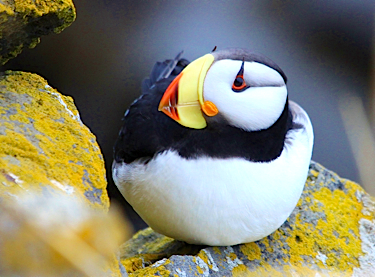
Horned Puffins
were common on the seabird cliffs at St. Paul, one of 10
species of Alcids seen on the island. (Photo by guide
Jesse Fagan)
BUFFLEHEAD (Bucephala
albeola)
BARROW'S GOLDENEYE
(Bucephala islandica)
COMMON MERGANSER
(Mergus merganser)
RED-BREASTED
MERGANSER (Mergus serrator)
Phasianidae (Pheasants, Grouse, and
Allies)
WILLOW PTARMIGAN (Lagopus lagopus)
ROCK PTARMIGAN
(Lagopus muta)
Gaviidae (Loons)
RED-THROATED LOON (Gavia stellata)
ARCTIC LOON
(Gavia arctica)
PACIFIC LOON
(Gavia pacifica)
COMMON LOON
(Gavia immer)
YELLOW-BILLED LOON
(Gavia adamsii)
Podicipedidae (Grebes)
HORNED GREBE (Podiceps auritus)
RED-NECKED GREBE
(Podiceps grisegena)
Procellariidae (Shearwaters and Petrels)
NORTHERN FULMAR (Fulmarus glacialis)
Phalacrocoracidae (Cormorants and Shags)
DOUBLE-CRESTED CORMORANT (Phalacrocorax auritus)
RED-FACED
CORMORANT (Phalacrocorax
urile)
PELAGIC CORMORANT
(Phalacrocorax pelagicus)
Accipitridae (Hawks, Eagles, and Kites)
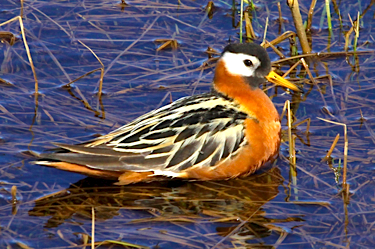
Unusual among
shorebirds, female phalaropes are more brightly-colored
than the males; the brilliant colors of this Red Phalarope
thus marks it as a breeding-plumaged female. (Photo by
guide Jesse Fagan)
BALD EAGLE (Haliaeetus
leucocephalus)
WHITE-TAILED EAGLE
(Haliaeetus albicilla)
NORTHERN HARRIER
(Circus cyaneus)
RED-TAILED HAWK
(HARLAN'S) (Buteo jamaicensis
harlani)
ROUGH-LEGGED HAWK
(Buteo lagopus)
GOLDEN EAGLE
(Aquila chrysaetos)
Falconidae (Falcons and Caracaras)
MERLIN (Falco
columbarius)
GYRFALCON (Falco rusticolus)
PEREGRINE FALCON
(Falco peregrinus)
Gruidae (Cranes)
SANDHILL CRANE (Grus canadensis)
Charadriidae (Plovers and Lapwings)
BLACK-BELLIED PLOVER (Pluvialis squatarola)
AMERICAN
GOLDEN-PLOVER (Pluvialis
dominica)
PACIFIC
GOLDEN-PLOVER (Pluvialis
fulva)
SEMIPALMATED
PLOVER (Charadrius
semipalmatus)
Haematopodidae (Oystercatchers)
BLACK OYSTERCATCHER (Haematopus bachmani)
Scolopacidae (Sandpipers and Allies)
COMMON SANDPIPER (Actitis hypoleucos)
SPOTTED SANDPIPER
(Actitis macularius)
WANDERING TATTLER
(Tringa incana)
LESSER YELLOWLEGS
(Tringa flavipes)
WHIMBREL
(AMERICAN) (Numenius phaeopus
hudsonicus)
BRISTLE-THIGHED
CURLEW (Numenius tahitiensis)
HUDSONIAN GODWIT
(Limosa haemastica)
BAR-TAILED GODWIT
(Limosa lapponica)
RUDDY TURNSTONE
(Arenaria interpres)
SANDERLING
(Calidris alba)
SEMIPALMATED
SANDPIPER (Calidris pusilla)
WESTERN SANDPIPER
(Calidris mauri)
LEAST SANDPIPER
(Calidris minutilla)
BAIRD'S SANDPIPER
(Calidris bairdii)
PECTORAL SANDPIPER
(Calidris melanotos)
ROCK SANDPIPER
(Calidris ptilocnemis)
DUNLIN (Calidris alpina)
STILT SANDPIPER
(Calidris himantopus)
SHORT-BILLED
DOWITCHER (Limnodromus
griseus)
LONG-BILLED
DOWITCHER (Limnodromus
scolopaceus)
WILSON'S SNIPE
(Gallinago delicata)
WILSON'S PHALAROPE
(Phalaropus tricolor)
RED-NECKED
PHALAROPE (Phalaropus lobatus)
RED PHALAROPE
(Phalaropus fulicarius)
Laridae (Gulls, Terns, and Skimmers)
BLACK-LEGGED KITTIWAKE (Rissa tridactyla)
RED-LEGGED
KITTIWAKE (Rissa brevirostris)
SABINE'S GULL
(Xema sabini)
BONAPARTE'S GULL
(Chroicocephalus philadelphia)
BLACK-HEADED GULL
(Chroicocephalus ridibundus)
MEW GULL
(AMERICAN) (Larus canus
brachyrhynchus)
HERRING GULL
(AMERICAN) (Larus argentatus
smithsonianus)
THAYER'S GULL
(Larus thayeri)
SLATY-BACKED GULL
(Larus schistisagus)
GLAUCOUS-WINGED
GULL (Larus glaucescens)
GLAUCOUS GULL
(Larus hyperboreus)
ALEUTIAN TERN
(Onychoprion aleuticus)
ARCTIC TERN
(Sterna paradisaea)
Stercorariidae (Skuas and Jaegers)
POMARINE JAEGER (Stercorarius pomarinus)
PARASITIC JAEGER
(Stercorarius parasiticus)
LONG-TAILED JAEGER
(Stercorarius longicaudus)
Alcidae (Auks, Murres, and Puffins)
COMMON MURRE (Uria aalge)
THICK-BILLED MURRE
(Uria lomvia)
BLACK GUILLEMOT
(Cepphus grylle)
PIGEON GUILLEMOT
(Cepphus columba)
MARBLED MURRELET
(Brachyramphus marmoratus)
KITTLITZ'S
MURRELET (Brachyramphus
brevirostris)
ANCIENT MURRELET
(Synthliboramphus antiquus)
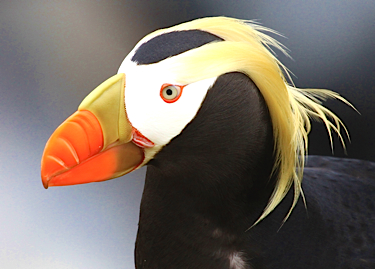
Tufted Puffins
offered up wonderful close photo ops at the St. Paul
seabird cliffs. (Photo by guide Jesse Fagan)
PARAKEET AUKLET (Aethia psittacula)
LEAST AUKLET
(Aethia pusilla)
CRESTED AUKLET
(Aethia cristatella)
RHINOCEROS AUKLET
(Cerorhinca monocerata)
HORNED PUFFIN
(Fratercula corniculata)
TUFTED PUFFIN
(Fratercula cirrhata)
Columbidae (Pigeons and Doves)
ROCK PIGEON (Columba livia)
Strigidae (Owls)
SNOWY OWL (Bubo
scandiacus)
SHORT-EARED OWL
(Asio flammeus)
Alcedinidae (Kingfishers)
BELTED KINGFISHER (Megaceryle alcyon)
Picidae (Woodpeckers)
DOWNY WOODPECKER (Picoides pubescens)
HAIRY WOODPECKER
(Picoides villosus) [*]
Tyrannidae (Tyrant Flycatchers)
ALDER FLYCATCHER (Empidonax alnorum)
Laniidae (Shrikes)
NORTHERN SHRIKE (Lanius excubitor)
Corvidae (Crows, Jays, and Magpies)
GRAY JAY (Perisoreus
canadensis)
STELLER'S JAY
(Cyanocitta stelleri)
BLACK-BILLED
MAGPIE (Pica hudsonia)
NORTHWESTERN CROW
(Corvus caurinus)

The feathered
feet and toes of ptarmigan (like this Willow Ptarmigan)
gave rise to their generic name Lagopus, which means "hare
foot." They are also a great adaptation to life in the
cold and snow. (Photo by guide Jesse Fagan)
COMMON RAVEN (Corvus corax)
Hirundinidae (Swallows)
TREE SWALLOW (Tachycineta bicolor)
VIOLET-GREEN
SWALLOW (Tachycineta
thalassina)
BANK SWALLOW
(Riparia riparia)
CLIFF SWALLOW
(Petrochelidon pyrrhonota)
Paridae (Chickadees and Tits)
BLACK-CAPPED CHICKADEE (Poecile atricapillus)
CHESTNUT-BACKED
CHICKADEE (Poecile rufescens)
BOREAL CHICKADEE
(Poecile hudsonicus)
Sittidae (Nuthatches)
RED-BREASTED NUTHATCH (Sitta canadensis)
Troglodytidae (Wrens)
PACIFIC WREN (ALASKAN ISLANDS) (Troglodytes pacificus alascensis)
Cinclidae (Dippers)
AMERICAN DIPPER (Cinclus mexicanus)
Regulidae (Kinglets)
GOLDEN-CROWNED KINGLET (Regulus satrapa) [*]
RUBY-CROWNED
KINGLET (Regulus calendula)
Phylloscopidae (Leaf-Warblers)
ARCTIC WARBLER (Phylloscopus borealis)
Muscicapidae (Old World Flycatchers)
BLUETHROAT (Luscinia
svecica)
NORTHERN WHEATEAR
(Oenanthe oenanthe)
Turdidae (Thrushes and Allies)
GRAY-CHEEKED THRUSH (Catharus minimus)
SWAINSON'S THRUSH
(Catharus ustulatus)
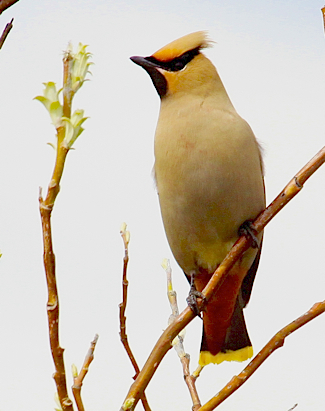
Bohemian Waxwings
are the default waxwing in most of Alaska, as Cedar
Waxwings are pretty much restricted to the south coast. We
saw several small groups around Denali. (Photo by guide
Jesse Fagan)
HERMIT THRUSH (Catharus guttatus)
AMERICAN ROBIN
(Turdus migratorius)
VARIED THRUSH
(Ixoreus naevius)
Sturnidae (Starlings)
EUROPEAN STARLING (Sturnus vulgaris)
Motacillidae (Wagtails and Pipits)
EASTERN YELLOW WAGTAIL (Motacilla tschutschensis)
Bombycillidae (Waxwings)
BOHEMIAN WAXWING (Bombycilla garrulus)
Calcariidae (Longspurs and Snow Buntings)
LAPLAND LONGSPUR (Calcarius lapponicus)
SNOW BUNTING
(Plectrophenax nivalis)
Parulidae (New World Warblers)
NORTHERN WATERTHRUSH (Parkesia noveboracensis)
ORANGE-CROWNED
WARBLER (Oreothlypis celata)
YELLOW WARBLER
(Setophaga petechia)
BLACKPOLL WARBLER
(Setophaga striata)
YELLOW-RUMPED
WARBLER (Setophaga coronata)
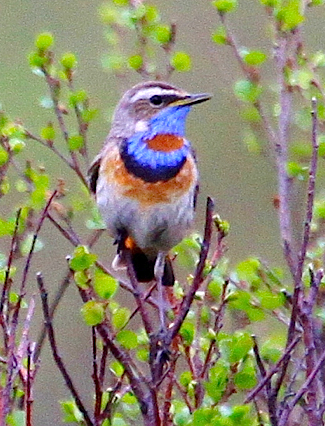
One of a handful
of mainly Old World songbirds that breed in Alaska, the
gorgeous Bluethroat is a highly sought-after target on
this trip. (Photo by guide Jesse Fagan)
TOWNSEND'S WARBLER (Setophaga townsendi)
WILSON'S WARBLER
(Cardellina pusilla)
Emberizidae (Buntings, Sparrows and
Allies)
AMERICAN TREE SPARROW (Spizella arborea)
SAVANNAH SPARROW
(Passerculus sandwichensis)
FOX SPARROW
(SOOTY) (Passerella iliaca
sinuosa)
FOX SPARROW (RED)
(Passerella iliaca zaboria)
LINCOLN'S SPARROW
(Melospiza lincolnii)
WHITE-CROWNED
SPARROW (GAMBEL'S) (Zonotrichia
leucophrys gambelii)
GOLDEN-CROWNED
SPARROW (Zonotrichia
atricapilla)
DARK-EYED JUNCO
(SLATE-COLORED) (Junco
hyemalis hyemalis)
Icteridae (Troupials and Allies)
RUSTY BLACKBIRD (Euphagus carolinus)
Fringillidae (Siskins, Crossbills, and
Allies)
GRAY-CROWNED ROSY-FINCH (PRIBILOF IS.)
(Leucosticte tephrocotis umbrina)
PINE GROSBEAK
(Pinicola enucleator)
WHITE-WINGED
CROSSBILL (Loxia leucoptera)
COMMON REDPOLL
(Acanthis flammea)
HOARY REDPOLL
(Acanthis hornemanni)
PINE SISKIN
(Spinus pinus) [*]
SNOWSHOE HARE
(Lepus americanus)
ALASKAN HARE
(Lepus othus)
HOARY MARMOT
(Marmota caligata)
ARCTIC GROUND
SQUIRREL (Spermophilus
parryii)
RED SQUIRREL
(Tamiasciurus hudsonicus)
TUNDRA RED-BACKED
VOLE (Clethrionomys rutilus)
BROWN LEMMING
(Lemmus sibiricus)
NORTH AMERICAN
PORCUPINE (Erethizon dorsatum)
ORCA (Orcinus orca)
DALL'S PORPOISE
(Phocoenoides dalli)
GRAY WHALE
(Eschrichtius robustus)
HUMPBACK WHALE
(Megaptera novaeangliae)
RED FOX (Vulpes vulpes)
ARCTIC FOX
(Alopex lagopus)
GRAY WOLF (Canis lupus)
BROWN (INCL.
GRIZZLY) BEAR (Ursus arctos)
POLAR BEAR
(Ursus maritimus)
SEA OTTER (Enhydra lutris)
CANADIAN LYNX
(Lynx canadensis)
STELLER'S SEA LION
(Eumetopias jubatus)
NORTHERN FUR SEAL
(Callorhinus ursinus)
HARBOR SEAL
(Phoca vitulina)
MOOSE (Alces alces)
CARIBOU (Rangifer caribou)
MOUNTAIN GOAT
(Oreamnos americanus)
MUSKOX (Ovibos moschatus)
DALL'S SHEEP
(Ovis dalli)
Totals for the tour: 174 bird taxa and 27 mammal taxa








